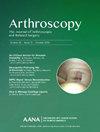Patient-Reported Outcome Measures Show No Relevant Change Between 1-Year and 2-Year Follow-Up After Treatment for Anterior Shoulder Instability: A Systematic Review
IF 4.4
1区 医学
Q1 ORTHOPEDICS
Arthroscopy-The Journal of Arthroscopic and Related Surgery
Pub Date : 2024-09-06
DOI:10.1016/j.arthro.2024.08.031
引用次数: 0
Abstract
Purpose
To compare patient-reported outcome measures (PROMs) at 1-year and 2-year follow-up after treatment for anterior shoulder instability.
Methods
Randomized controlled trials and prospective studies that evaluated and reported PROMs after a capsulolabral repair (with or without remplissage), bone augmentation, or nonoperative treatment to treat anterior shoulder instability at both 1-year and 2-year follow-up were included. PROMs were compared between 1-year and 2-year follow-up; forest plots with mean difference were created to compare baseline, 1-year, and 2-year follow-up; and scatterplots were created to visualize clinical improvement over time.
Results
Fourteen studies, comprising 923 patients, with levels of evidence Level I and II were included. Nine PROMs, of which predominantly were the Western Ontario Shoulder Instability Index (WOSI; 11 studies; 79%), were evaluated. Minimal to no statistically significant change in WOSI, Oxford Shoulder Instability Score, American Shoulder and Elbow Surgeons (ASES), Subjective Shoulder Value, Simple Shoulder Test, Disabilities of Arm, Shoulder, and Hand (DASH), Quick DASH, Single Assessment Numeric Evaluation, or visual analog scale was observed between 1-year and 2-year follow-up. Pooling of the WOSI, Oxford Shoulder Instability Score, ASES, and Single Assessment Numeric Evaluation demonstrated improvement from baseline to 1-year follow-up and minimal to no change between 1-year and 2-year follow-up. Scatterplots of the WOSI and ASES demonstrated the most improvement within 6 months and no clear improvement after 1-year follow-up. Recurrence rates increased with time but varied between studies.
Conclusions
In contrast to recurrence rates, which have been shown to increase with time, minimal to no statistically significant change was observed for any of the included PROMs between 1-year and 2-year follow-up. This finding raises the question as to whether it is necessary to evaluate PROMs in long-term follow-up of patients after shoulder stabilization treatment.
Level of Evidence
Level II, systematic review of Level I and II studies.
肩关节前方失稳治疗后 1 年和 2 年随访期间,患者报告的结果指标未显示相关变化:系统性综述。
目的:本研究的主要目的是比较肩关节前方不稳定治疗后 1 年和 2 年随访期间患者报告的结果指标(PROMs):方法:纳入随机对照试验和前瞻性研究,这些试验和研究评估并报告了肩关节囊修复术(带或不带再植术)、骨隆起术或非手术疗法治疗肩关节前方不稳定后 1 年和 2 年随访的 PROM。比较了1年和2年随访的PROMs,绘制了带有平均差的森林图以比较基线、1年和2年随访的情况,并绘制了散点图以直观显示随时间推移的临床改善情况:共纳入 14 项研究,包括 923 名患者,证据等级为 I 级和 II 级。共评估了 9 项 PROMs,其中主要是西安大略省肩关节不稳定性指数(WOSI;11 项研究;79%)。在 1 年和 2 年的随访期间,WOSI、牛津肩关节不稳定性评分 (OSIS)、美国肩肘外科医生 (ASES)、主观肩关节值 (SSV)、简单肩关节测试 (SST)、手臂、肩部和手部残疾 (DASH)、快速 DASH、单次评估数字评价 (SANE) 或视觉模拟量表 (VAS) 均未观察到明显的统计学变化。对 WOSI、OSIS、ASES 和 SANE 进行汇总后发现,从基线到 1 年随访期间的情况有所改善,而 1 年随访到 2 年随访期间的情况变化极小甚至没有变化。WOSI 和 ASES 的散点图显示,6 个月内的改善幅度最大,随访 1 年后则无明显改善。复发率随着时间的推移而增加,但不同研究之间存在差异:结论:复发率会随着时间的推移而增加,与此形成鲜明对比的是,在 1 年和 2 年的随访期间,所纳入的任何 PROMs 在统计学上都没有显著变化。这一发现对是否有必要在肩关节稳定治疗后的长期随访中评估PROMs提出了质疑:证据等级:II级,对I-II级研究的系统回顾。
本文章由计算机程序翻译,如有差异,请以英文原文为准。
求助全文
约1分钟内获得全文
求助全文
来源期刊
CiteScore
9.30
自引率
17.00%
发文量
555
审稿时长
58 days
期刊介绍:
Nowhere is minimally invasive surgery explained better than in Arthroscopy, the leading peer-reviewed journal in the field. Every issue enables you to put into perspective the usefulness of the various emerging arthroscopic techniques. The advantages and disadvantages of these methods -- along with their applications in various situations -- are discussed in relation to their efficiency, efficacy and cost benefit. As a special incentive, paid subscribers also receive access to the journal expanded website.

 求助内容:
求助内容: 应助结果提醒方式:
应助结果提醒方式:


